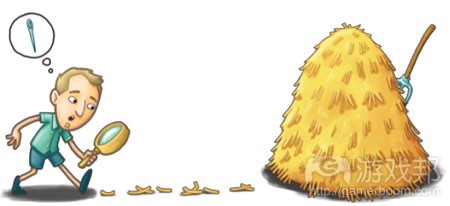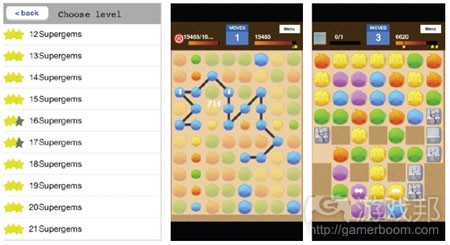Wooga开发者分享评估游戏原型的方法
作者:Antti Hattara
制作一款成功的手机游戏并不容易。
无论你是独立开发者还是大公司,选择合适的项目都是一件严峻的任务。
在Wooga,我领导的Pocket工作室专注于制作面向大众市场的休闲游戏。
在游戏开发行业,判断一个原型是否成功,似乎存在简单而有趣的方法。
听起来很简单。那么到底如何评估原型?
虽然我现在要介绍的三步评估法绝不是成功的完美配方,但可以帮助我们评估原型。
第一步:明确想法
新想法总是由某个人想出来的,想法本身有各种不同的形式。
有些人可能很难解释清楚自己的想法。在这个阶段,通常会觉得大部分想法听起来都有很大潜力。
为了让想法更具可比性,我们会把它们写在一页纸上,内容包括核心玩法和特点(或者为什么它是独特的,或明智的)。
一页纸看起来不长,但一页纸就足够把想法和它独特的原因解释清楚了。把想法写下来还可以促使你从玩家的角度思考。
在写这一张纸时,你必须明确以下几点:
目标:我们想做/达到的东西是否清楚?
时机:是否吸引人?
可控制的范围:是否有明确清楚的目标?说明是否容易理解?
渴望:是否能维持做下去的兴趣?是否有重制的潜力?
如果有几个不同的想法,以上几点可以帮助你找出哪个想法最困难、最独特或最有市场。
以下是我们的案例《Jelly Splash》——一款益智游戏和它的地图。
第二步:原型和计分
对于原型,我们要考虑两个问题:是否直观?是否具有重玩价值?
为了确定它是否直观,我们要做玩家测试。我们希望确定原型的基本要素是合适的,主题是有趣的,目标是清楚的。
如果你做的是针对大众市场的游戏,以上目标就要提前达到,否则拖后面就很难办了。
为了评估,你必须有一个参考基准,可以是你自己的游戏的测试结果,也可以是用竞争对手的游戏做测试的结果。后一种方法就比较卑鄙了,但也很管用。
第二步是添加一些计分方法到游戏中,让你对游戏的优势和劣势有一个粗糙的但全面的了解。它还引入有意义的选择,这是让游戏变得有趣的关键。
对于《Jelly Splash》,我们使用关卡;而在《Pocket Village》中,我们使用时间。
这两种方法都意味着玩家可以重回游戏。特别是对于《Pocket Village》,玩家可以做一些决定了他们如何在有限的步骤或时间内进展的选择。
第三步:比赛
到这时,我们的目标——制作一款能上手的有趣游戏应该完成了。
在第三步,我们的目标是测试:
设计的深度
可扩展性(即了理游戏需要多少内容)
比赛有助于用更多玩家在更长的时间内测试游戏。我们让玩家在Facebook上分享他们的经验和得分。
根据玩家分享,我们可以评估玩家沉浸感和活动。例如:
如果大量玩家在第三关时失败,那么说明第三关太难了。
添加一个3星评分系统是否能够吸引玩家重回游戏?或者高分榜?
以上是这个阶段必须解决的问题。如果玩家就是没有重回游戏,那么这个原型就失败了。
但如果这个阶段成功了,那么你的游戏就成功了。
总结
这绝不是成功的完美配方!
品味在变,玩家也在变,游戏世界没有不变应万变的法则。到目前为止,这个方法对我们仍然很适用,并且帮助我们取得了一些成果。
第一步:游戏应该明确而吸引人,即核心和特点。
第二步:直观和可重复玩,即一致的、有趣的想法加上有意义的选择。
第三步:沉浸感和延展性,即可拓展性和免费模式的设计工作。
本文中使用的原型案例《LINES》已经变成游戏《Jelly Splash》了。
我们已经对这款游戏做了足够多的测试,所以我们在Casual Connect SF 2013上公布它了。
它将于8月15日在iPhone和iPad平台发布,紧接着还将推出Facebook版和Android版。我们已经迫不及待了。(本文为游戏邦/gamerboom.com编译,拒绝任何不保留版权的转载,如需转载请联系:游戏邦)
Prototyping at Wooga: How to find the needle in the haystack
by Antti Hattara
Being successful on mobile is no small matter.
Whether you’re a indie developer or a more established company, choosing the right projects to work on can be a demanding task.
I lead the Pocket Studio at Wooga, where we’re focused on making casual, mass-market games.
Being in the business of making games, there’s a seemingly simple way of telling if a prototype is a winner; is it fun?
That sounds straightforward. But how do you evaluate this?
While it’s by no means a perfect recipe for success, a three-phase framework currently helps us evaluate our prototypes.
Phase One: The Pitch
A new idea always starts with a person and the ideas themselves can come in many different forms.
Some can be harder than others to explain, and at this stage it’s usual that most ideas sound like they could have a lot of potential.
To make the ideas more comparable we reduce them to a pitch line and a one-pager that communicates the core gameplay and the twist (or why it is unique, or better).
It sounds short, but one page should be enough to successfully communicate the idea and why it’s special. It also pushes you to think from the player’s perspective.
With the one pager a few things should be clear:
Objective: Is it clear what we want to do/achieve?
Opportunity: Does it sound appealing?
Manageable scope: Does it have a well-defined and clear goal? An understandable spec?
Desire: Is it appealing to work on? Is there potential for iterations?
If there are several different ideas, this process helps us evaluate which adds the biggest twist or is the most unique and which has the biggest potential market.
Here’s an example of something we moved forward with; a move-based, line-drawing puzzle game with maps.
Here we could see that we’d be testing the mechanic with levels, and that this would make it easier and faster to prototype.
Phase Two: The Prototype & Scoring
With the prototype we’re looking at two things; is it intuitive, and is it replayable?
To find out if it is intuitive we do user testing. We want to confirm that the basics are in order, that the theme is exciting, and that there is an intuitive goal.
If you are going for a mass-market game those are going to be tough to fix later.
To evaluate these you need to have reference benchmarks which can either be previous tests or tests done with a competitors’ game. One’s sneakier than the other, but both work.
The second step is to add some method of scoring into the game that sets the focus and gives you a rough, yet broad, overview of your game’s strengths and weaknesses. It also introduces meaningful choice, essential for making a game fun.
With Jelly Splash we used level targets, and in Pocket Village we used time.
These both meant that players would come back, and with Pocket Village in particular, players would have to make choices that determine the course of their progression with limited moves or time.
Phase 3: Competitions
By this stage the aim should be to have a fun game that is approachable. In phase 3, our objective is to test…
The depth of design, and Extendability (i.e. get a sense of how much the game requires on the content side).
A competition helps test the game with a larger amount of users and over a longer period of time. We used a Facebook group to source players to share their experiences and scores.
From here, we could measure engagement and activity.
If a lot of players are dropping out at level 3, then chances are level 3 is too hard.
Is adding a 3-star scoring system enough to ensure people come back, or would a high score list be better suited to your game?
These are all scenarios this stage should answer. If people simply aren’t coming back, is it time to call it a day on this prototype?
But if the third stage is successful, you might just be onto a winner.
Summary
This is by no means a fixed recipe for success – I wish!
Tastes changes, players evolve and there is no sure fire bet in the app world. This approach has served us well so far, though, and sticking to the following three steps has already produced some interesting results.
Phase 1: The game should be well defined and appealing, i.e. the core and the twist
Phase 2: Intuitive & replayable, i.e. solid idea for fun via meaningful choice
Phase 3: Engaging & extendable, i.e. scalable and the design works for free-to-play
The examples used in this article for LINES have since turned into Jelly Splash.
The game has passed every test we could throw at it, and so we announced it today on stage at Casual Connect SF 2013.
It will launch on iPhone and iPad on 15 August, shortly followed by the Facebook and Android versions of the game. We can’t wait.(source:pocketgamer)
上一篇:阐述随机性在电子游戏中的使用
下一篇:非开发者在制作游戏时需注意的事项











































 闽公网安备35020302001549号
闽公网安备35020302001549号